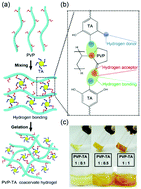Hydrogen bonding-based strongly adhesive coacervate hydrogels synthesized using poly(N-vinylpyrrolidone) and tannic acid†
Abstract
When multiple intermolecular interactions occur simultaneously, complexed molecules undergo gelation by inter-cohesive bonding, inducing a pseudo-crosslinking effect to form a supramolecular gel. Among the number of substances that can induce supramolecular assembly, phenolic species such as 3,4-dihydroxy-L-phenylalanine (DOPA) are widely utilized for synthesizing adhesive materials. However, despite the strong adhesion capability of monomeric phenol, it lacks cohesive strength and rarely forms a supramolecular gel to secure its mechanical properties. In this study, to overcome this obstacle, we synthesized a supramolecular coacervate hydrogel by simply mixing poly(N-vinylpyrrolidone) (PVP) and tannic acid (TA), resulting in strong cohesive interactions by virtue of the larger molecular size of TA and reinforced molecular interactions attributed to the presence of galloyl groups with a high density. We further analyzed the rheological and adhesive properties of PVP–TA coacervate hydrogels, revealing that they could exhibit not only a self-healing property, but also super adhesive properties with an average adhesion strength of 3.71 MPa on a glass substrate, which is >4 times stronger than that of conventional PVP.



 Please wait while we load your content...
Please wait while we load your content...